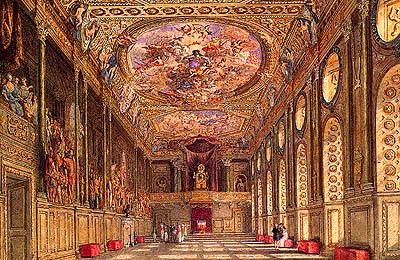
RBH Home
Maps & Travels
Articles
Legends
Towns & Villages
Castles & Houses
Churches
Biographies
Gentry
Family History
Odds & Ends
Mail David
Windsor Castle
Parliamentary Stronghold
In 1642, the Parliamentary army
occupied Windsor and, in the following year, fifty-five political
prisoners were lodged here under the command of Colonel Venn, who
despoiled the chapel and destroyed the deer in the Great Park. In 1647, Charles
I was a prisoner in the palace of his ancestors. After escaping
from Hampton Court and being confined in Carisbrooke, he was brought back
to Windsor in close custody of Colonel Whichcott. The Governor was allowed
£20 a day for his expenses. A month later, in January 1649, he was
removed to London. After his execution at Whitehall, there ensued much
discussion as to his place of burial, Windsor finally being chosen. A
hearse, driven by the King's old coachman and attended by four servants,
conveyed the body to Windsor. The Governor refused to allow the use of the
burial service in the Book of Common Prayer. With much difficulty, the
vault of Henry
VIII and Jane, his wife, was discovered. The Duke of Richmond
scratched on a piece of lead, "King Charles, 1648," the year
being then reckoned to end on the 25th March. The following day, the
King's coffin was brought out when, presently, it began to snow and the
snow fell so fast that, by the time the corpse came to the west end of the
Royal Chapel, the black velvet pall was all white, the colour of
innocence, being thick covered with snow." The coffin was placed on
two trestles in the vault and the velvet pall thrown in upon it.
"Thus went the White King to his grave in the 48th year of his
age," without ceremony or religious service. Around the same time,
the castle itself was very nearly pulled down. The relevant bill in
parliament was defeated by just one vote!
 In Charles II's reign, the State apartments were remodelled, the architect
being Sir Hugh May, who probably only carried out the designs of Sir
Christopher Wren. Verrio painted the walls and ceilings and Gibbons carved
the fittings. The £70,000 voted for a tomb to the memory of Charles I was
probably spent in these new buildings. Samuel Pepys visited Windsor in
1666 and was conducted to "where the late King is buried, and King
Henry and my Lady Seymour. This being, done, to the King's house and to
observe the neatness and contrivance of the house and gates. It is the
most romantic castle that is in the World. But Lord! The prospect that is
in the balcony that is in the Queen's lodgings, and the terrace and walk,
are strange things to consider, being the best in the World, sure; and so,
giving a great deal of money to this and that man and woman, we to our
tavern and there dined."
In Charles II's reign, the State apartments were remodelled, the architect
being Sir Hugh May, who probably only carried out the designs of Sir
Christopher Wren. Verrio painted the walls and ceilings and Gibbons carved
the fittings. The £70,000 voted for a tomb to the memory of Charles I was
probably spent in these new buildings. Samuel Pepys visited Windsor in
1666 and was conducted to "where the late King is buried, and King
Henry and my Lady Seymour. This being, done, to the King's house and to
observe the neatness and contrivance of the house and gates. It is the
most romantic castle that is in the World. But Lord! The prospect that is
in the balcony that is in the Queen's lodgings, and the terrace and walk,
are strange things to consider, being the best in the World, sure; and so,
giving a great deal of money to this and that man and woman, we to our
tavern and there dined."
James II lived much at Windsor. He alienated his subjects by committing
the fatal error of receiving the Papal Nuncio and it was here that the
Prince William of Orange held the consultation which resulted in the former's
flight. William's sister-in-law, Queen Anne, here gave birth to a child, baptised Anne Sophia, who, dying
soon after, was buried in Henry VIII's vault. In 1700, the Duke of
Gloucester, the longest lived of all Anne's nineteen children, died at
Windsor, to the great grief of the nation. It was in one of the rooms now
forming part of the Royal Library of this castle that Queen Anne was
sitting, with the Duchess of Marlborough, when the news of the great
victory of Blenheim arrived.
Part
7: Georgian Phoenix
Edited from PH Ditchfield's "Bygone
Berkshire" (1896)
